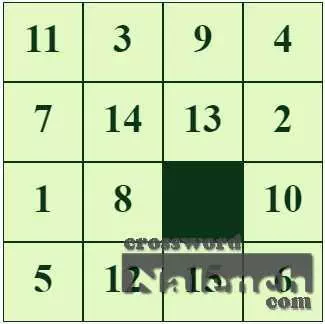Next Морской бой
 Головоломка Лабиринт Previous
Головоломка Лабиринт Previous
 Головоломка Лабиринт Previous
Головоломка Лабиринт PreviousGame Fifteen is a puzzle played on a square two-dimensional board with numbered tiles. The object of the Puzzle puzzle is to arrange the tiles of the board from smallest to largest, from left to right, top to bottom, with an empty space in the lower right corner of the board, as shown above.
Sliding any tile that delimits the whiteboard space in that space is "movement." While the above configuration represents a game that has already been won, notice how tile 12 or tile 15 can be pushed into empty space. However, tiles cannot be moved diagonally or forcefully removed from the board.
While other configurations are possible, we will assume that this game starts with the tiles on the board in reverse order, from largest to smallest, left to right, top to bottom, with empty space in the lower right corner of the board. However, if and only if the board contains an odd number of tiles (i.e. the board's height and width are even), the positions of the tiles numbered 1 and 2 must be swapped as shown above.
[b]The Fifteen Game[/ b] is a puzzle game invented by American Sam Loyd (1841–1911) in the second half of the 19th century.
The game consists of a square frame with fifteen figures, numbered from 1 to 15, and one open field. In the case of repetitive movements, the parts must be arranged in ascending order.
Sliding any tile that delimits the whiteboard space in that space is "movement." While the above configuration represents a game that has already been won, notice how tile 12 or tile 15 can be pushed into empty space. However, tiles cannot be moved diagonally or forcefully removed from the board.
While other configurations are possible, we will assume that this game starts with the tiles on the board in reverse order, from largest to smallest, left to right, top to bottom, with empty space in the lower right corner of the board. However, if and only if the board contains an odd number of tiles (i.e. the board's height and width are even), the positions of the tiles numbered 1 and 2 must be swapped as shown above.
[b]The Fifteen Game[/ b] is a puzzle game invented by American Sam Loyd (1841–1911) in the second half of the 19th century.
The game consists of a square frame with fifteen figures, numbered from 1 to 15, and one open field. In the case of repetitive movements, the parts must be arranged in ascending order.
Comments:
Be the first to comment on the crossword puzzle!
New crossword puzzle comments:
Петро Полюхович © 2011-2024
Join us if you are a true crossword puzzler!


 Login
Login Crosswords
Crosswords Conundrums
Conundrums Sudoku
Sudoku English
English Turkish
Turkish About
About